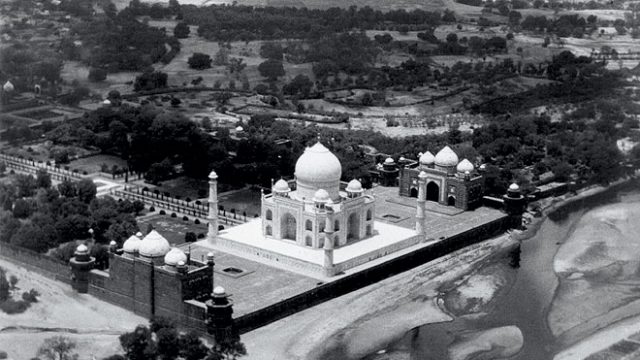“The Taj truly is…a poem…It is not only a pure architectural type, but also a creation, which satisfies the imagination, because its characteristic is Beauty. Did you ever build a Castle in the Air? Here is one brought down to earth, and fixed for the wonder of ages; yet so light it seems, so airy, and when seen from a distance, so like a fabric of mist and sunbeams, with its great dome soaring up, a silvery bubble, about to burst in the sun…” wrote Bayard Taylor, a journalist, after his visit to the Taj Mahal in 1850. Those were pre-flight days. And even though it was man who took to the air first, the Taj retained its lyrical lightness, and remained the most conspicuous structure in the whole of North India for aviators. Aerial views of the Taj were one of the major attractions of the Imperial Airways’ Empire Air Routes (England-India-Malaya-Australia) which were established in 1936. The flight path from Delhi to Cawnpore took airplanes over Agra in the United Provinces, and gave travellers mesmerizing views of the “beautiful marble tomb erected by Shah Jehan in 1632.”
When the Second World War brought the American Air Force into Indian skies Glenn S. Hensley, was a young photographer participating in the surveillance of the Japanese in Burma. He was based in Calcutta, the operational headquarters and the main air supply post for the entire CBI (China Burma India) theatre. During his off-duty time Hensley captured a number of locations around India, including the Taj, in this panoramic shot. The original caption to the picture is rather understated: “As the plane circles the Taj, the view is towards the northwest. The airfield is visible upper left side. MacDonell Park is just beyond the Taj grounds.”
The silvery gleam of the Taj, which Taylor talked about in such ecstatic tones and Hensley captured in series of photographs, is also, a perfect marker from the air and a dead give-away to enemy pilots in wartime. The understandable but unsightly tradition of camouflaging the Taj in wartime had its bizarre beginnings in World War II, when the monument was briefly covered in scaffolding to give the impression that it was a stockpile of bamboo. The camouflage (with green cloth) returned in the 1971 war and the Kargil conflict. From the air, as from the ground, the dazzling domes of the Taj have always, it seems, been the centre of attraction on the dusty plains of north India.




